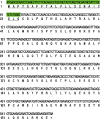Abbreviations
E. coli
IFN
IPTG
IRF
ISG
LPS
MDBK
MDCK
OAS
JAK
STAT
VSV
WISH
INTRODUCTION
MATERIALS AND METHODS
Cells and reagents
RNA extraction and RT-PCR for TA cloning
Construction of IFNα8 expression vector
Expression and purification of recombinant proteins
Cytopathic effect of antiviral assay
RT-PCR
RESULTS
Constitutive expression of IFNα in porcine peripheral whole blood cells
 | Figure 1The regulation of porcine IFNα8 transcript. RT-PCR was performed with the whole blood RNA from Korean domestic pig (Sus scrofa domestica) under stimulation of LPS, polyinosinic-polycytidylic acid (Poly I:C), and VSV at time point of 3 h. The control β-actin showed no difference in transcript. The data represents one of 4 independent experiments.
Ctl, control; LPS, lipopolysaccharide.
|
 | Figure 2Translated amino acid sequence of porcine IFNα. The nucleotide sequence was used to convert into amino acid sequence. The hydrophobic signal sequence of 69 base pairs nucleotide sequences were highlighted by green color with underlined 23 amino acid residues. This sequence was deposited in databank and obtained accession number as “KX275310”. |
Amino acid sequence of IFNα8 from Korean domestic pig
 | Figure 3Comparison of porcine IFNα8 to the known porcine IFNα. The ORF of porcine IFNα8 mRNA from Korean domestic pig was analyzed and newly identified as porcine IFNα8 (accession No. KX275310). The amino acid sequence was deduced by newly obtained the DNA sequence of porcine IFNα8 and the different amino acid residue of Korean porcine IFNα8 compared to porcine IFNα8 (accession No. ACV42397). Three distinct amino acid residues are highlighted with yellow color.
ORF, open reading frame.
|
Expression of recombinant porcine IFNα8 protein
 | Figure 4The expression and purification of recombinant porcine IFNα8 with Talon affinity chromatography. The recombinant porcine IFNα8 mRNA from Korean domestic pig was expressed in E. coli and purified by a mini-Talon metal affinity column. (A) The IPTG-induced recombinant porcine IFNα8 detected with mouse anti-his6-tag monoclonal antibody. The arrow indicated porcine IFNα8 induced in the presence of IPTG for 3 h. (B) The a mini-Talon metal affinity chromatography purified recombinant porcine IFNα8 was visualized by Coomassie blue staining. The data represents one of 5 independent experiments. |
 | Figure 5The purification of porcine IFNα8 by anion exchange chromatography. (A) UV absorbance at 280 nm was recorded during the porcine IFNα8 the second step purification process with anion chromatography. (B) The purified recombinant porcine IFNα8 fractions were visualized by silver staining. (C) The bound fractions of recombinant porcine IFNα8 were pooled for quantification to compare with BSA in silver staining. The data represents one of 5 independent experiments.
BSA, bovine serum albumin; UV, ultra-violet.
|
Antiviral activity of porcine IFNα8 against VSV
 | Figure 6Recombinant porcine IFNα8 reduces the cytopathic effect caused by VSV. (A) Human epithelial WISH, (B) bovine MDBK, (C) canine MDCK cells were treated with recombinant porcine IFNα8 including positive control human IFNα2 then infected with VSV to analyze the reduction of cytopathic effect. The plate was visualized with crystal violet staining. The concentration of porcine IFNα8 (20 ng/ml) and human IFNα2 (2 ng/ml) were added by the 2-fold serial dilution. For control, the wells at bottom row were non-infected cells; the rows above non-infected wells were only VSV infected cells which shows the complete cytopathic effect to VSV challenge. The data represents one of 5 independent experiments.
hIFN, human interferon; pIFN, porcine interferon.
|
The antiviral activity of porcine IFNα8 via Mx-1 and OAS-1
 | Figure 7Recombinant porcine IFNα8 induces antiviral genes. (A) Bovine MDBK, (B) human WISH, and (C) canine MDCK cells were treated with human porcine IFNα8 (20 ng/ml) and human IFNα2 (2 ng/ml) at indicated time points (3 and 6 h). Non-treated cells were prepared as negative control. After treatment of IFNs, total RNA was extracted for RT-PCR of Mx-1, OAS-1, and β-actin for normalization. The data represents one of 3 independent experiments.
Ctl, control; hIFN, human interferon; pIFN, porcine interferon.
|




 PDF
PDF ePub
ePub Citation
Citation Print
Print


 XML Download
XML Download